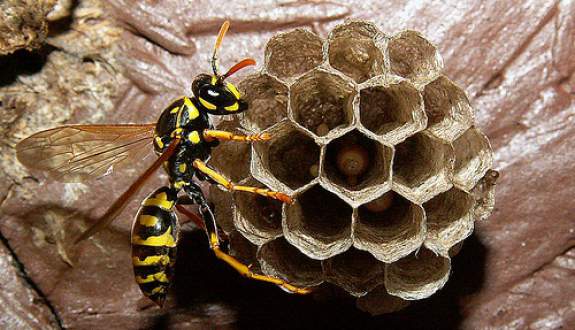Should a Wall Void Yellowjacket Nest Be Removed?
By Chris Williams on October 8, 2013.

Question
About a month ago we discovered that we had a yellowjacket nest hidden in the wall void in our garage. We had the nest treated with insecticide and were told that any surviving yellowjackets would be dying soon so there wasn’t any reason to do anything further. Is that right? Should we just leave that nest inside the wall? The technician said it was pretty big.
Answer
It’s true that, in the fall, yellowjackets gradually become less active and workers begin to die. Only a few yellowjackets that are destined to be next year’s queens survive the winter. And you’ll be happy to know that, in our area, yellowjackets don’t re-use old nests. In the spring, the queen yellowjackets will start new nests in new locations.
There’s always been a difference of opinion, even among pest management professionals, as to whether you should go through the effort and expense of removing a wasp or bee nest inside a building void. There are two main concerns if the nest is left in place: odor from decaying yellowjackets and their larvae, and other pests that may move into the nest to feed on the dead yellowjackets.
Whether or not there is an odor problem will depend on the temperature and how many yellowjackets (or larvae) were occupying the nest at the time it was killed. A yellowjacket nest is at its highest capacity in mid to late summer. If your nest was killed a month ago, you should have noticed any odor by now. If there is a noticeable odor, deodorizing agents can be injected into the wall void. Some professionals vacuum yellowjackets from the nest before they treat, leaving fewer dead bodies.
The second problem occurs when dermestid beetles, ants, silverfish, and other insects that feed on dead insects move into the void to feed on dead yellowjackets. That won’t be a concern if the nest was treated with a long-lasting insecticide since the residual will kill those invaders as well. If the nest was treated with a quick action, short-term insecticide, other insects may be able to survive in the wall void. Make sure that the outside opening into the nest is sealed to help prevent entry by other insects.
Other factors that might influence whether or not the nest is removed are the size of the nest, and whether or not you know its exact location in the void. For most homeowners, the decision usually comes down to whether nest removal can be easily and cheaply done. Removing a nest from a garage wall void, where appearance and finish work may not be a high priority, shouldn’t be complicated. If the wall was already damaged when the nest was treated, you may choose to open it further. On the other hand, because the nest was in a garage wall void and not in a living space, you are less likely to be directly impacted by any problems caused by leaving the nest in place.